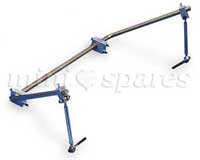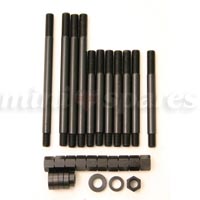
Jack rear of car up, and place securely on axle stands, positioned to allow maximum access to rear subframe/rear radius arms area. Remove rear exhaust hanger to exhaust clamp or un-hook rubber loop on late type cars. Using suitable saw, cut off centralising tab from bottom center of subframe rear cross member. Remove rear wheels and brake drums. Remove upper most and rear most brake back plate to radius arm nuts and bolts. Read more

Instruction Sheet (Please read in full before installing anti-roll bar)
The mounting blocks are to be fixed at each end of the bar under the front of the subframe where there is a double thickness of metal close to the forward tie-bar brackets. Loosely assemble the blocks to the bar, one positioned between the locating rings - offer the bar up to the lower front edge of the front subframe. Read more

FOR USE WITH STANDARD TIE BARS ONLY
This bar has been developed to complement those road cars fitted with post 1990 rubber springs. Being the softest compound yet used on the Mini in an attempt to improve comfort, they allow more body-roll. This bar will not only reduce body-roll, but also slightly reduce dive under braking and squat under acceleration. The bar is aimed at the general daily driver. For more progressive drivers it is highly recommended that its used in conjunction with rear anti-roll bar kit C-AJJ4009. Read more

Performance orientated engines, particularly those utilising large over-bore sizes (i.e. 73.5mm), can suffer from premature head gasket failures because of the inadequate quality and performance from the standard head studs. Mini Spares has therefore produced a replacement kit to eliminate these problems. Read more
Vertical rear moulding for the Estate and Traveller rear side windows.
14.4375” or 367mm With the double row channel grooves facing upwards. This is a side view elevation. This channel will require the ends to be cut exactly as above to the original angle of 20 degrees and the correct length as shown which ensures the best fitment. As the material is not the easiest to cut cleanly it is recommended that a new hacksaw blade or good quality snips are used and the channel grooves are packed with wood splints. Alternatively, you can use your old original sample as a template. 14A7631 – FRONT VERTICAL MOULDING HAS SQUARE ENDS, 340MM LONG Alternatively, use your old original sample as a template
Read moreThe correct running temperature of the oil is perhaps even more important than the water/coolant temperatures - so let us consider how to control them.
Mainly because it seems to be the most misunderstood of the whole process, and oil cooler fitment almost a reflex when over-heating occurs where a tuned engine of any type is concerned. And in many cases on standard production road cars for that matter.
Almost since the appearance of the immortal Cooper S, fitting an oil cooler has been the essential thing to do to any tuned Mini without any comprehension why. The original fitment was necessary because oil and bearing technology wasn't too advanced. Asking an oil of yester-year to cope with lubricating an engine at racing speeds, and a gearbox pushed their performance to the edge of their all too narrow capability, so extreme control over their working environment was essential for reliability. Hence oil cooler fitment.
Read moreIt's criminal. Folk spend fortunes putting together super-sonic motors, only to skimp on the oil they use. Why? Oil's oil right? Wrong. Even if it's a standard engine, it deserves TLC considering it's extremely hostile working environment.
Oil is literally the engine's life-blood. The opening few sentences are astonishingly true. Oil isn't there just to prevent all metal components within an engine fusing together in the first few seconds of running, creating a total melt down of Chernobyl proportions. It's an intricate blending of chemicals to protect the engine as a whole.
The most commonly uttered statement about engine wear is most wear occurs within the first 10 minutes from start up when cold. True if cheap chip fat oil is used.In performance and race engines, a considerable amount of wear is created by heat, load, speed, and pressure. Again, cheapy oil won't give protection here. Read more
Essential to the well being of every engine is its oil pump and oil. Much in the same way as the heart and blood is deemed relatively important to us humans! It's also another of those greatly misunderstood and, unfortunately, misrepresented subjects connected to engines.
An alarming number of so-called A-series engine specialists would have you believe that once parting with a veritable bundle of your hard earned readies on that mega motor, what you really need to keep it in good health is a high-pressure/high-flow oil pump. Seems a sensible consideration - except in the A-series world it's impossible. Oh, there are pumps that will give better flow rates than others, but high pressure? Absolutely not.
Oil pressure is regulated by the relief valve in the block of an A-series, not in the oil pump as with say a Ford. Yeah, you know - the one that gets jammed, causing heart failure as you believe your crank bearings have dissolved, and is a pig to get out. Read more
Here's something unusual that cropped up a little while ago that I've never commented on before - main oil gallery plugs/bungs.
I'd been conversing via e-mail with a guy that was experiencing weird oil flow/supply problems with his performance street engine. Initially he'd been blaming it on the supposedly superior oil pump he'd bought. He sent it to me; I inspected it and found it to be in perfect health with no signs of causing the issues in hand. Firstly there was a claimed total oil drain down from the pump causing lack of initial supply on start-up for a few seconds, and then repeated crank bearing failures when used in anger (i.e. at high rpm for protracted periods). Unless there is something drastically wrong with the oil pump and fitment - cracked pump body, non-flat mounting surface, mounting bolts too long, split gasket, etc. - it will not drain down simply because the inlet and outlet ports are above the centerline, near the top of the pump as it is mounted to the block. Read more
OK, so what's happened to the Min Tec/Mini Spares development program?
It has been a long time between my first few words on basic injection car tuning and these - for that I apologise, but business has been unbelievably fraught this year.
I did promise regular and frequent up-dates, but the best laid plans, and all that… As I said, business has been more than brisk.
OK, so what's happened to the Min Tec/Mini Spares development program? Apart from a whole lot of investigation and repetitive research into what's available currently - not that much. It is all hinging on this forthcoming ECU from this particular company. Unfortunately the company concerned is not run by businessman or automotive engineers. They are electronics whiz kids who are trying to achieve the Holy Grail. Read more
During a recent discussion with a few overseas Mini brethren - who were experiencing various engine-related problems - something cropped up that I have always taken as granted (in the sense of ' a standard for the application'); the matter of consistency in measurements.
Now we're not talking about the sort of measurements you make with a ruler, since discrepancies of a small nature don't tend to matter a whole lot. No, we're talking about the sort of measurements made with fine measuring instruments such as micrometers or vernier calipers.
Now, the discussion that was going on was with reference to the best clearance to run between the bore and piston for a given piston type for race or street purposes. I hade quoted figures that I generally use for both situations for forged and for cast piston types. Read more
This is the frequently abused and mis-used stuff dolloped on to bolts/nuts to stop them coming undone. Having seen and heard of many horror stories concerning this stuff, I thought a few words of caution and common sense wouldn't go amiss.
There is a plethora of types on the market with no easy reference as to which to use for what application except in certain cases. Loctite have a very useful guide, their dealers generally able to help with choosing which is best for any given application. The trouble comes when folk buy stuff unwittingly from their local 'do it all' motorist/car spares place. Good stuff is expensive, and it doesn't go all that far. But at least it does its job when used in the correct applications. Unfortunately many buy a cheaper variety with not quite the same application strength, and then apply twice as much hoping it will do the job. It doesn't. Read more

